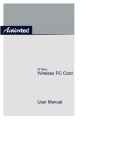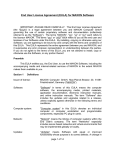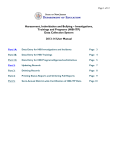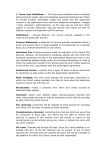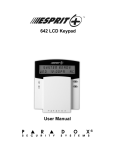Download Table of Contents
Transcript
Table of Contents Page I. Introduction ………………………………………………………………02 II. Connecting the Prism Wireless Adapter……………………… 03 III. Installing the Prism Wireless Adapter………………………….04 Configuring Windows 98 SE……………………………………………….04 Configuring Windows ME…………………………………………………..06 Configuring Windows 2000…………………………………………………08 Configuring Windows XP…………………………………………………. 11 IV. Configuring the Prism Wireless Adapter……….…………….. 13 V. Configuring the AdHoc Feature…………………………………17 VI. Configuring File and Print Sharing ………………………………..20 1 Table of Contents Introduction Thank you for purchasing the Prism Wireless Adapter. This Prism Wireless Adapter is Connecting the Prism Wireless Adapter 1. It will not affect the installation process if your computer is on or off. However, if easy to use and easy to setup. If you are tired of all those messy wires just to connect a your computer is off then after you have connected the Prism Wireless Adapter, laptop to your Home network, then take your networking to the next level with the please be sure to turn on your computer. Prism Wireless Adapter. You will be able to share files, printers and even your High-Speed Internet access, all without wires. 2. Insert the Prism Wireless Adapter into the appropriate USB slot on either the front or the back of your PC. Package Contents z Make sure the following items came in this package: z Prism Wireless Adapter z USB Cable z Prism Wireless Adapter Installation and User’s Manual CD Minimum System Requirements z One Pentium class computer, 200 Mhz or higher (preferably 300 Mhz or above) z Microsoft Windows 98 Second Edition (SE), Microsoft ME, Microsoft 2000 installed. 2 Introduction Connecting the Prism Wireless Adapter 3 Installing the Prism Wireless Adapter 3. Please insert the Prism Wireless Adapter Installation CD into your CD-ROM drive. Select CD-ROM Drive and then click Next. For Windows 98 SE 1. After you have installed the Prism Wireless Adapter your computer will display an Add New Hardware Wizard screen. Click Next. 2. In the next screen, select the option Search for the best driver for your device 4. The installation is now complete. Please click Finish . (Recommend) and then click the Next button. 4 Installing the Prism Wireless Adapter Installing the Prism Wireless Adapter 5 5. It will be necessary for you to restart your computer. Please click OK to restart 2. The installation is now complete. Please click Finish. your computer. Windows ME 1. After you have installed the Prism Wireless Adapter your computer will display 3. It will be necessary for you to restart your computer. Please click OK to an Add New Hardware Wizard screen. Click Specify the location of the driver restart your computer. If this screen does not appear please restart your (Advanced) . Then click the Next button. computer manually. 6 Installing the Prism Wireless Adapter Installing the Prism Wireless Adapter 7 For Windows 2000 1. After you have installed the Prism Wireless Adapter your computer will display the Found New Hardware Wizard screen. Click Next. 2. In the next screen, select the option Search for the suitable driver for my device and then click the Next button. 8 Installing the Prism Wireless Adapter 3. Please insert the Prism Wireless Adapter Installation CD into your CD-ROM drive. Select Specify a location and then click Next. 4. Your computer will locate the correct drivers named “AEIWLNIC.inf”. Click Next to install the drivers. Installing the Prism Wireless Adapter 9 For Windows XP 5. The Digital Signature Affirms screen will appear. Click Yes to continue the installation process. 1. After you have installed the Prism Wireless Adapter your computer will display a Found New Hardware Wizard screen. Select Install from a list or specific location (Advanced), and then click Next to continue. 6. Then please click Finish to complete the installation process. 10 Installing the Prism Wireless Adapter 2. Give the directory where you have stored the Win XP Driver. Click Next. Installing the Prism Wireless Adapter 11 3. Once your system detected the driver, Microsoft will show a warning message. Configuring the Prism Wireless Adapter Click Continue Anyway for next step. After you have installed the software for the Prism Wireless Adapter an Icon will appear in your Task Bar on the lower right hand side on your Desktop. You will not be automatically connected to your Home Gateway or Access Point. Follow these steps to configure your Prism Wireless Adapter. Prism Wireless Adapter Status Icon 4. The installation is now complete. Please click Finish. 1. Right click on the Prism Wireless Adapter Status Icon. A list will appear as shown in the picture below. Make sure that there is a black dot next to the Turn Wireless Radio On. If the dot is not present then simply select it. Then you want to select the Advanced Configuration... selection from the given list. 12 Installing the Prism Wireless Adapter Configuring the Prism Wireless Adapter 13 2. The Prism Wireless Adapter’s Properties screen will appear. Under the Note: To use Wireless LAN Utility under Windows XP, the “Automatic Wireless Configuration tab the SSID value should be the same as the ESSID value of Network Configuration” needs to be disabled first by uncheck the check box Use your Home Gateway or Access Point. For example, if you have configured your Windows to configure my wireless network settings in the Wireless Network Home Gateway or Access Point’s ESSID value to “PRISM” then this same Connection Properties window under Control Panel. value needs to be typed into the SSID field in the following screen. 3. After you have entered the appropriate SSID value click Apply and then click OK. Your Prism Wireless Adapter will now be able to connect to your Home Gateway or Access Point. Note: When the Prism Wireless Adapter is Green it means that your wireless connection is strong or good. When it is Yellow it means that your wireless connection is fair. When it is Red it means that your wireless connection is poor or weak. When the bar is Yellow or Red you may experience slower connection speeds then when they are Green. 14 Configuring the Prism Wireless Adapter Configuring the Prism Wireless Adapter 15 Encryption (WEP) You can use Encryption to add a level of security to your Prism Wireless Adapter Configuring the AdHoc Feature network. This is not a required feature. If you are using a Home Gateway or Access Point you must be sure to use the same Encryption (WEP) keys for your Prism For Win 98 SE, ME, 2000 Wireless Adapter. Please follow these steps to set this feature up: AdHoc enables two or more computers with the Prism Wireless Adapter to talk to each 1. Right click on the Prism Wireless Adapter Status Icon. A list will appear as shown other. The most common usage for this feature is multi-player games in which each in the picture on the previous page. Then select Advanced Configuration…from the player can play the game from each computer against one another via this Adhoc given list. network. If you use the AdHoc feature then a Home Gateway or Access Point is not 2. Click on the Encryption tab. required. Please follow these steps to set up the AdHoc feature: 3. You can either select 64 bit or 128 bit Encryption depending on your needed level of security. You can select Create Keys with Passphrase (a passphrase is the same as a password, with the same type of functionality). Once you have entered 1. Right click on the Prism Wireless Adapter Status Icon. A list will appear as shown in the picture below. Then select Advanced Configuration... from the given list. a pass phrase the utility will automatically generate the 4 keys. Remember, if you are using a Home Gateway or Access Point these keys will need to be added to it. If you already have a set of keys configured into your Home Gateway or Access Point or you prefer to create the keys manually, select Create Keys Manually and enter them in the given fields. Click Apply and then OK to activate your settings. 16 Configuring the Prism Wireless Adapter Configuring the AdHoc Feature 17 2. In the Profile field type in any name you wish. This will save all the settings under that name. Then click on the down arrow in the Mode field and select 802.11 For Windows XP 1. Panel. In the Control Panel window double click the Network Connections icon. AdHoc. Enter an SSID value in the given field. The SSID value should be the same on each computer that you want to network together. Then in the AdHoc On your computer’s desktop click Start, then select Setting and then select Control 2. Channel box select a channel between the numbers 1-13. This value also must be The Wireless Network Connection properties screen will appear. Click Wireless Networks tab, and then select Advanced. the same on each computer that you wish to network. Finally, click Apply and OK to activate the settings. Be sure to repeat this for each computer you want to network. 3. The following screen will appear. Please select Computer-to-computer (AdHoc) network only. Click Close. 18 Configuring the AdHoc Feature Configuring the AdHoc Feature 19 Configuring File and Print Sharing 3. In the Select Network Component Type screen, click Service and then click the Add button. If you have and are using a Home Gateway or Access Point you can establish a network that will allow you to share files and printers. This is an easy method to set up a network in your home or small office. Please follow these steps to setup file and print sharing: For Windows 95, 98 and ME 1. On your computer’s desktop click Start, then select Settings and then select Control Panel. In the Control Panel window double click the Network icon. 2. The following Network screen should appear. Click the Add button. 4. In the following screen please select File and printer sharing for Microsoft Networks from the given list. 20 Configuring File and Print Sharing Configuring File and Print Sharing 21 5. In the File and Print Sharing screen make sure that both of the selection have a check mark beside them. If they do not please click on the box next to each statement and then click OK. 7. Click on the Configuration tab. This will take you back to the screen from step 2. In the Primary Network Logon: box, located just above the File and Print Sharing button, make sure that Client for Microsoft Networks is selected. If it is not then click the down arrow and select it from the given list. Click OK. 6. After you have clicked OK you will return to the network screen from step 2. Please click on the Identification tab (see the first image on page 19). z z 8. A screen will appear asking you to restart your computer. Click Yes to restart the computer. If you do not see this screen please restart your computer manually. Computer Name: In this field you can type any name you want. (i.e. My After your computer restarts you will be asked to supply a User Name and Computer, John, CPU654) Do not use the same name for each computer you Password. Enter whatever you would like but be sure to write down these values, wish to have on your network. as they will enable you to access your network. Workgroup: This field enables you to set a unique name for your network. This name must be set up on every computer you wish to have on your network. z Computer Description: You can enter anything you wish. Traditionally, the location name or main user’s name is used in this field. 22 Configuring File and Print Sharing Configuring File and Print Sharing 23 9. After your computer has restarted and you entered a password and user name, z Read Only: This will allow other users on your network to view and read the you must enable a file or drive for sharing. Locate the file or drive you wish to share. file or drive you selected. They will not be able to modify it in any way. You (The easiest way to achieve this is through your Windows Explorer, located in the can further restrict their privlidges by entering a password in the appropriate start menu.) Right click on the File or Drive you wish to share. In the given menu field. select Sharing. z Full: This will allow other users on your network to read, modify, move and delete any information in the shared drive or file. You can further restrict their privlidges by entering a user name and password. z Depends on Password: This will allow you to set both Read Only and Full access on the shared file or drive. The level of access will depend on the passwords you enter in the appropriate field. When you are finished click Apply and then OK. 10. The following screen will appear. Please select Shared As. This will enable other users on your network to see the file or drive you selected. Then you can choose the Access Type: 24 Configuring File and Print Sharing Configuring File and Print Sharing 25 11. Next you need to share your printer. On your desktop, click Start, click Settings, and then select Printers. 2. In the System Properties click on the Network Identification tab. If the “Workgroup” name is already the same as all the other computers on your network, 12. Right click on the printer you want to share. Select Sharing from the given list. then you do not need to change it. Click OK. If it is not the same then click 13. The next step will be to enable the sharing by selecting the Share As button. It Properties. will automatically insert a default name for the Share Name. You may set a password for the printer at this time if you want to restrict who on the network can use this resource. You may also set the default printer settings by modifying information on the other tabs of this window. For Windows 2000 1. After you have installed and configured your USB Adapter, Windows 2000 will automatically enable file and print sharing for your computer. The only item that needs to be altered is your workgroup settings. All the computers on your network must have the same workgroup name but different computer names. To check or change this locate the My Computer icon on your desktop. Right click on it and select Properties from the given list. 3. In the Computer Name: box type a name that is different from your other PC’s on your network. Then, in the Workgroup box type the name that you are using to identify your network. This will be the same on each computer on your network. Click OK and you will return to the System Properties screen. Click OK again and even if you are not asked to do so, please restart your computer. 26 Configuring File and Print Sharing Configuring File and Print Sharing 27 2. The following screen will appear. Please click Sharing tab and If you understand the risk but still want to share the root of the drive. Click here then OK. For Windows XP 1. On your computer’s desktop click My Computer, Right click on the File or Drive you wish to share. In the given menu select Sharing and Security… 3. The Enable File Sharing screen will appear, please select Just enable file sharing. Click OK button. 28 Configuring File and Print Sharing Configuring File and Print Sharing 29 4. After you have clicked OK, the Sharing dialogue will appear again, please select the first check box and type a share name on the Network sharing and security box. When you are finished click OK. 30 Configuring File and Print Sharing



















